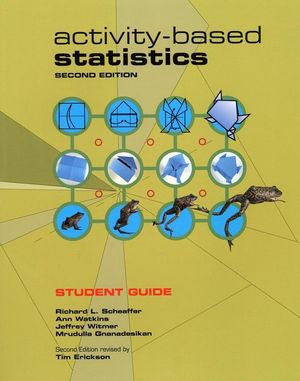|
Textbook
Activity-Based Statistics, 2nd Edition Student GuideISBN: 978-0-470-41209-1
Paperback
274 pages
June 2008, ©2004
 This is a Print-on-Demand title. It will be printed specifically to fill your order. Please allow an additional 10-15 days delivery time. The book is not returnable.
|
||||||
To the Student.
Acknowledgments.
I. EXPLORING DATA.
A Living Histogram.
How to build a histogram out of people.
Getting to Know the Class.
Surveying the class. Exploratory data analysis. Displaying
categorical and
quantitative data.
A Living Box Plot.
How to construct a box-and-whisker plot with people. Shape, center, and spread.
V Is for Variation: How Far Are You from the Mean?
Measuring variability in data.
Matching Plots to Variables.
Connecting our knowledge of real-life distributions to their graphs.
Matching Statistics to Plots.
Matching summary statistics to graphs of distributions. How the
mean can differ
from the median.
Variation in Measurement.
Collecting measurement data and looking at its distribution.
Measurement Bias.
Experiencing measurement bias.
Let Us Count.
Variation due to the process of measurement.
Matching Descriptions to Scatter Plots.
Making the correspondence between scatter plots and statistics
(regression line
and r).
The Regression Effect.
Find out about the regression effect.
Leonardo's Model Bodies.
Looking at correlation between the sizes of different body parts.
Relating to Correlation.
How the correlation coefficient from a sample varies about the
true population
coefficient.
Models, Models, Models . . . .
Modeling time series data with lines. Breaking the time series
into two pieces.
Predictable Pairs.
Relationships between categorical variables. Association in
two-way tables.
Ratings and Ranks.
The relationship between ratings and ranks.
II. PLANNING A STUDY.
Random Rectangles.
Sampling bias. The importance of random sampling.
The Rating Game.
Analyzing ratings that are results from a questionnaire you design.
Stringing Students Along.
Learning about selection bias.
Gummy Bears in Space.
Factorial designs and interaction. Controlling variables.
Funnel Swirling.
Experimental design, particularly factorial design.Variability in an experiment.
Jumping Frogs.
Experiments in a factorial situation. Estimating the effects of
each factor and of
the interaction.
How to Ask Questions: Designing a Survey
How the way a question is worded can affect the outcome of a survey.
III. ANTICIPATING PATTERNS.
What Is Random Behavior?
Gambler's fallacy. It’s hard to predict short-term random behavior.
The Law of Averages.
What is the law of averages? How probability helps us predict in the long term.
Streaky Behavior.
Runs in Bernoulli trials. Randomness is streakier than we think.
Counting Successes.
How to create simulations to study problems about the number of
successes in
repetitions of an event with a known probability.
Waiting for Sammy Sosa.
The geometric, or waiting-time, distribution.
The Lazy Student.
What happens to the spread when you add random variables.
What's the Chance?
Dependent and independent trials.
Spinning Pennies.
Sampling distributions. Distribution of sample proportions where p 0.5.
Cents and the Central Limit Theorem.
How the sampling distribution of the mean of a nonnormal
distribution looks
normal.
Sampling Error and Estimation.
How an estimate (for example, of a mean) based on a sample
differs from the
population value.
How Accurate Are the Polls?
How an estimate of a proportion differs from the population
value. How the
spread of sampling distributions defines a margin of sampling
error.
IV. STATISTICAL INFERENCE.
How Many Tanks?
Estimating a population from serial numbers. Unbiased estimators.
Estimating the Total of a Restaurant Bill.
Sources of bias in estimation. Compensating for bias.
What Is a Confidence Interval Anyway?
Explaining the confidence interval as the range of plausible population values.
Confidence Intervals for the Proportion of Even Digits.
The meaning of the confidence level.What affects whether 95% of the confidence
intervals contain the true value.
Capture/Recapture.
Estimating population size using a capture/recapture technique.
How to Ask Sensitive Questions.
Randomized response sampling. Using probability techniques to
disguise survey
answers and preserve confidentiality.
Estimating a Total.
It is not always clear how to sample to get the best estimate.
The Bootstrap.
Creating an interval estimate for statistics when the
traditional confidence
interval may be inappropriate.
Statistical Evidence of Discrimination.
Using the randomization test to show that variables are associated.
How Typical Are Our Households’ Ages? The Chi-Square Test
Using chi-square to show that (binned) age distributions are different.
Coins on Edge.
The power of a hypothesis test increases as the sample size increases.
V. PROJECTS.
Theme: Exploration of Data and Improvement in Quality.
Application: Improved Payment Processing in a Utilities Firm.
Theme: Sample Survey.
Application 1: A Typical Election Poll.
Application 2: The Nielsens.
Theme: Experiment.
Application: Does Aspirin Help Prevent Heart Attacks? The Physicians' Health Study.
Theme: Modeling.
Application: Body Composition.
References.
Index.



